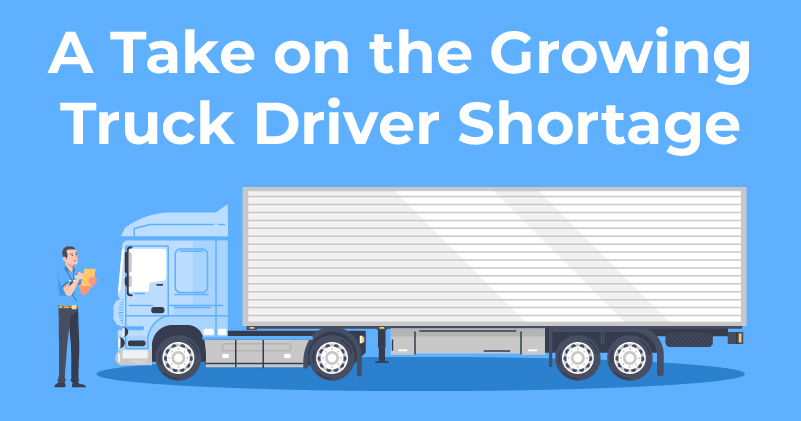
In the sprawling global commerce network, where goods move ceaselessly across vast distances, the backbone of transportation lies with truck drivers. Yet, amidst this vital link, the trucking industry faces a critical challenge – a shortage of more than 80,000 truck drivers, which casts a shadow over the smooth flow of goods and the functioning of supply chains.
Our latest blog is a take on the growing truck driver shortage and it delves deep into the intricacies of the truck driver shortage, uncovering the multifaceted reasons behind this pressing issue. From the demanding lifestyle that truckers lead to the sway of regulatory pressures, we explore the factors that influence truck drivers to leave the industry.
The Current Landscape of the Truck Driver Shortage
This scarcity is attributed to factors such as the demanding nature of the profession, an aging workforce, and regulatory constraints that contribute to the departure of drivers, as indicated by the insights from the American Transportation Research Institute.
Retirement, it seems, plays a role in reshaping the trucking landscape. As seasoned drivers retire, a gap emerges, and a younger generation might not be as keen to embrace the profession. We investigate how the allure of other industries, coupled with perceptions of the trucking life, affect the pool of potential drivers.
The implications extend well beyond the transportation realm, spilling into the very heart of logistics and distribution networks. As the backbone of modern commerce, trucking is pivotal in ensuring that products move from manufacturers to retailers and consumers. The shortage strains these networks, causing delays, reduced efficiency, and ultimately higher consumer costs.
The Complex Web of Causes
- Challenging Lifestyle:
The demanding lifestyle of a trucker is a significant deterrent for potential drivers and a source of turnover for existing ones. Prolonged hours on the road, extensive time away from home and family, and the job’s physical toll contribute to a less appealing work environment.
- Aging Workforce:
The industry’s aging driver population is another facet of the problem. As experienced drivers retire, they take a wealth of knowledge and expertise. The resulting knowledge gap compounds the shortage, making it challenging to replace seasoned drivers.
- Regulatory Pressures:
Regulations, such as Hours of Service rules, shape the workday of a trucker. While designed for safety, these rules can also limit flexibility and earnings potential. Stricter regulations might deter potential drivers and contribute to driver attrition.
The Impact Beyond Transportation
The tentacles of the truck driver shortage reach far beyond transportation. Industries that rely on just-in-time delivery, such as manufacturing, retail, and healthcare, experience disruptions that reverberate across supply chains. Delays in manufacturing inputs, shortages of consumer goods, and even delayed medical supplies can result from this bottleneck in transportation.
Innovative Solutions to Bridge the Gap
- Technology Adoption:
Innovative technologies like autonomous trucks and route optimization software hold promise for mitigating the shortage. These solutions can potentially reduce the burden on drivers, increase efficiency, and lower costs.
- Recruitment Strategies:
To attract fresh talent, the industry is exploring new recruitment strategies. By targeting underrepresented groups and demographics and offering competitive incentives, benefits, and comprehensive training programs, the trucking sector aims to make the profession more appealing.
- Regulatory Reforms:
Regulation flexibility could make the profession more manageable and enticing for potential drivers. Reforms that balance safety concerns with the needs of drivers could address some of the workforce’s challenges.
Collaborative Efforts and Industry Partnerships
Collaborations between transportation companies, educational institutions, and industry associations are taking root to combat the shortage. These partnerships focus on training, raising awareness about the industry’s opportunities, and advocating for policies that support the workforce.
Conclusion
The truck driver shortage is a multi-faceted challenge with profound implications. The need for comprehensive solutions becomes apparent as it extends its reach into various sectors. Addressing the shortage requires a collective effort that transcends individual interests, prioritizing the stability of the industry and the broader economy. In this endeavor, we at TMS-Digital stand out as leaders. As a top-rated trucking software and solutions provider in the US, TMS-Digital has consistently emphasized the driver shortage problem and driver safety, showcasing a commitment to tackling industry-wide challenges.
As you explore potential solutions and contribute to the conversation, consider partnering with TMS-Digital. We are actively shaping the landscape and working towards a more sustainable and efficient future for trucking.










